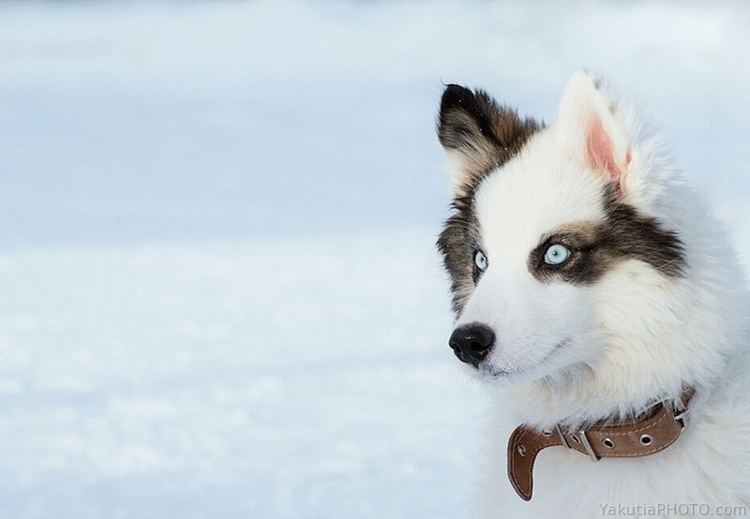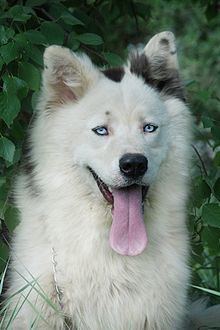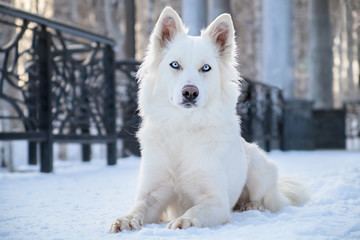Other names Yakut Laika Scientific name Canis lupus familiaris Rank Breed | Height Male | |
 | ||
Male 53–56 centimetres (21–22 in) Female 52–55 centimetres (20–22 in) Coat Double coated, with a thick downy undercoat, and a longer, more coarse top coat. Color A wide variety of colours and markings, but quite commonly black and white, or solid white. Can also be white with spots, tri-colour, brown, and grey. Solid black is the only colour not allowed per the RKF Breed Standard. Similar Russo‑European Laika, East Siberian Laika, West Siberian Laika, Karelo‑Finnish Laika, Yakutian horse | ||
The Yakutian Laika (Russian: Якутская лайка) is a working dog breed that originated in the Arctic seashore of the Sakha (Yakutia) Republic. The major habitat is estuaries of Kolyma, Indigirka, Yana and Lena. In terms of functionality, Yakutian Laikas might serve as a reindeer herder’s dog (olenegonka), hunter’s dog, and a sled dog.
Contents

Yakutian laika puppies welpen jakutischer laika
History

Yakutian Laikas were developed in ancient times by native Yakuts involved with hunting mammals and birds; the dogs were indispensable assistants. They proved to be a valuable asset and became companions to the Yakuts. In the Sakha language, this breed is known as "Sakha yta" meaning "Yakut dog".
Description

This is a versatile dog with excellent sense of smell, hearing and vision, strong hunting drive, endurance; they are aggressive to predators and soft and gentle to humans. They are multi-purpose, have got excellent sense of smell, absolute pitch and good eyesight. They are tireless and with good anger towards predators. At the same time, they’ve got kind character and are very faithful to people. Yakutian Laikas are not demanding to conditions of life and easily endure the hostile climate of northern Siberia. In harsh Siberian conditions they reveal their stamina; they tend to work in small groups and can work through the whole day, from dawn to sunset. Popularity of dog sledding appeared with the arrival of Russian traders to the Arctic. With the increased demand for white polar foxes in the 17th century, the Arctic exploration received its spike. Furs and mammoth tusks trade became local nations’ main income. Origin and subsequent formation of the breed are still not quite known, but because of the hard to access country and extreme natural conditions, Yakutian Laikas have lived as primitive aboriginal breeds; they were rarely confined and mated free. Naturally, local type dogs could be preserved only under conditions of complete isolation from dogs of other breeds. First scientific descriptions of dogs of Yakutia were published in late 18th century, when first geographic studies of the north were conducted. Prince Shirinsky-Shikhmatov wrote in his monograph about Laikas: “Researchers of the north, of course, could not overlook northern dog; they could not disagree with hard fact that presence of this dog makes life of northern people possible. It is even more strange that so little attention was paid to description of dogs of the north; their ancestral aboriginal type and numerous varieties remain obscure. There are as many types of Laikas as ethnic minorities of the north; varieties of Laikas differ clearly from each other, each has its own peculiarities and their division is indisputable”. This monograph was written in 1898. Russian Geographic Society gave task to Mr. Maak to investigate Vilyuisk District. “Review of Vilyuiks District of Yakutian Provionce” was published in 1877. Maak wrote: “I saw dog of very typical appearance and very common in Siberia, which was fox-like”. In 1896, V. L. Seroshevsky published a book “Yakuts”, edited by N. I. Veselovsky. Describing dogs of Yakuts, Seroshevsky divides them into two groups, 1) guarding and hunting dogs and 2) maritime sled dogs. He wrote: “even most poor Yakut having no other animals, has at least one dog”. Yokhelson (Johelson?), 1898, in his publication “Hunting Industry in Kolyma Territory of Yakutian Province” and described the Tungus Lajka used for sledding and hunting dogs. He wrote: “There are two breeds of dogs, one is so-called Tungus Laika, a pointed-eared dog of nomadic reindeer herders and polar sled dog”. All researchers described dogs of Yakutia as one breed of “polar sled dogs”. Yokhelson wrote: “Sled dog is a burden animal not only of nomads living in not forested country, but also of settled near the river Russians and russified minorities and the dog of majority of cattle keeping Yakuts. Except southwestern part of the territory, one can find 5-6 dogs in every yurta, which are used for hauling firewood and other works needed by the household. The polar dog is not big, 50-60 cm at the shoulder… In the appearance, with his prick ears, oblique set eyes, thick coat and broad massive head, pointed muzzle, low carried tail (when the dog is tired, eats or in a bad mood), the dog is very similar to wolf. Among them, there are shaggy dogs, and somewhat blunt muzzle not different from our Spitzes … Generally, type of Kolyma sled dog is diverse and, perhaps, it is a mix between Kamchatka and Eskimo sled dogs with another imported breed.” It stands to a reason that other dogs relocated here together with new immigrants. Both Seroshevsky and Yokhelson described the Yakutian Sled Dog similarly: “Legs relatively thick and short, chest, which is used to pull sleds, perfectly developed; neck is thick and short. Face is unusually intelligent and with melancholic or grim expression”. In principle, it remains so today and the dogs little changed with the spreading civilization in the Yakutian north.
In 2011 the Fédération Cynologique Internationale (FCI) approved a breed standard.


